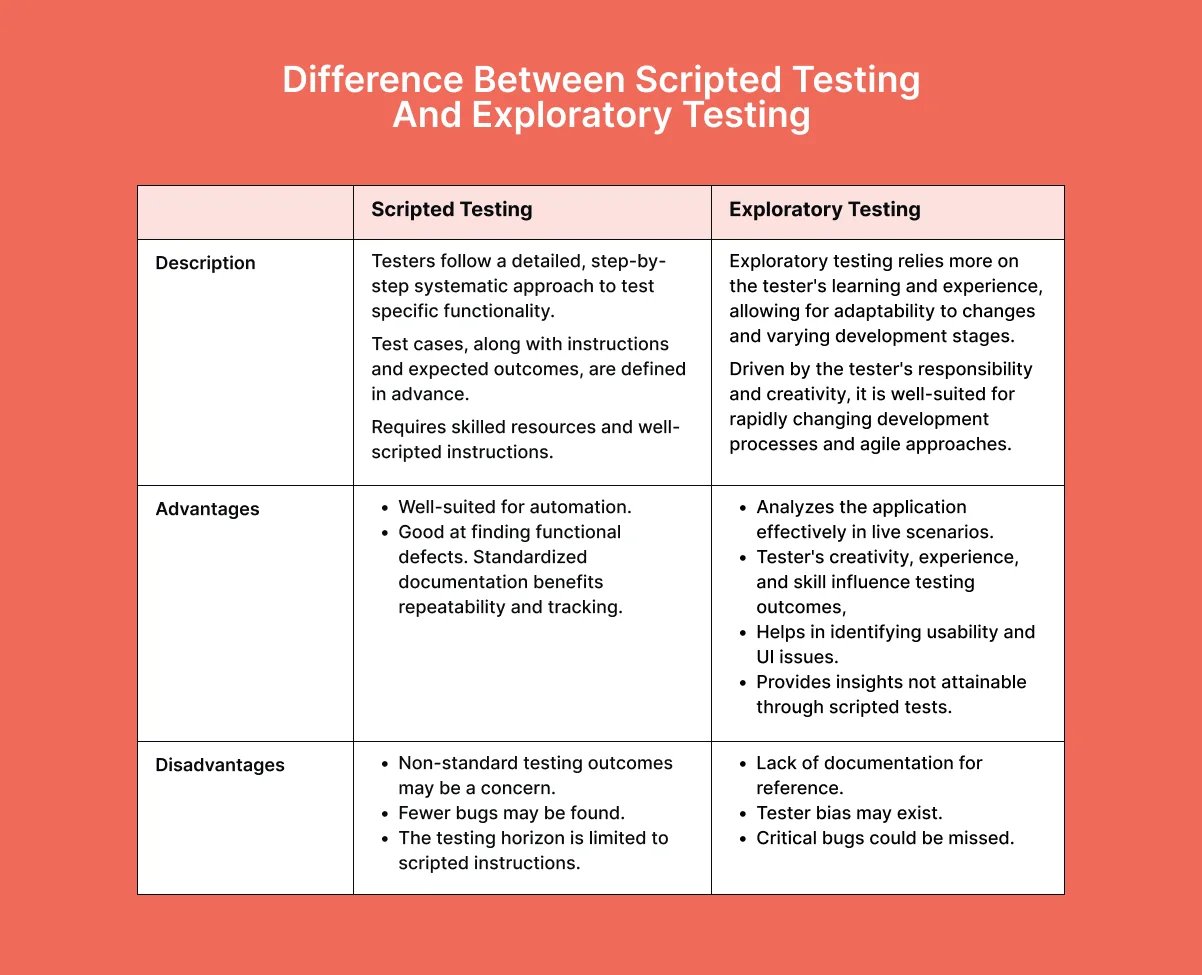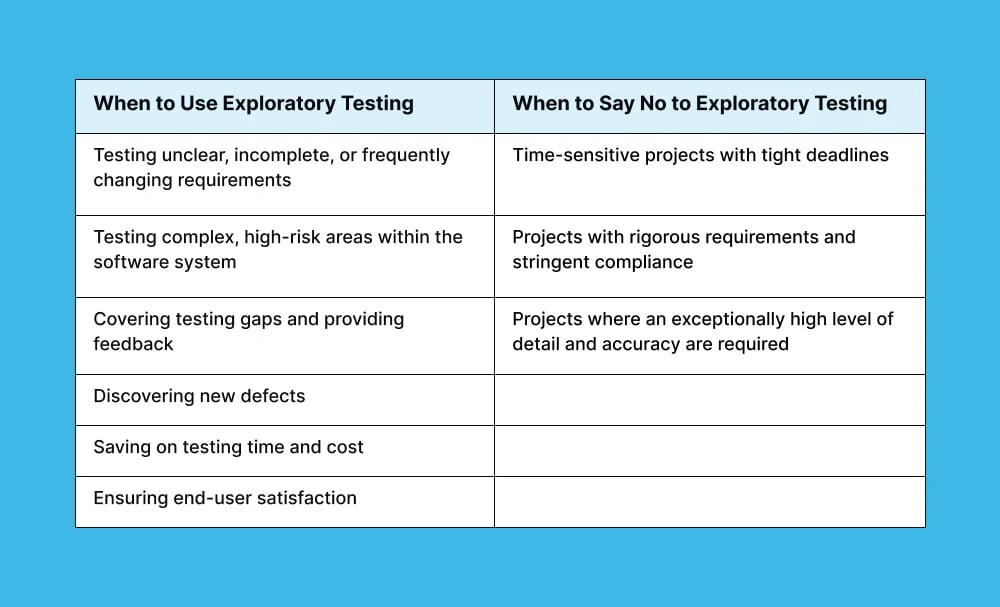What is Exploratory Testing? - The Ultimate Guide
Is your approach to software testing rigid and inflexible? Do you find yourself struggling to find hard-to-replicate bugs that surface under specific scenarios? Then it's time to consider exploratory testing!
Want to drive your global growth in local markets?
We can help you drive global growth, better accessibility and better product quality at every level.
What is Exploratory Testing?
Exploratory testing is a highly effective approach to testing software that gives testers the freedom to adapt and experiment on the fly based on their observations of the system and user behaviors. It allows you to unlock the full potential of your testing team and achieve better results by catching issues that rigid and traditional testing approaches might miss.
Why Exploratory Testing?
Exploratory testing lets testers use their skills and know-how to run tests. It helps them find problems quickly while also gathering useful feedback on the product. What sets it apart is the ability for testers to adapt their methods as they go, ensuring thorough coverage and efficient problem-solving.
Is Exploratory Testing always Functional Testing?
Like many QA definitions, we’ve seen “exploratory testing” used in multiple ways. The term usually refers exclusively to functional testing. In this article, we’ll use “exploratory test” to mean “exploratory functional test.” However, within the Global App Testing product, you can ask our testers to focus on multiple kinds of issues, including functional, localization, and usability issues.
We call this an “audit” (our launchpad doesn’t refer to it as “exploratory testing” for this reason), and you can easily select it when you launch a test.
What's the difference between Scripted testing and Exploratory testing?

When is Exploratory Testing done?
At the core of all product and QA decisions lie the needs of the business. To enhance the durability of your quality assurance procedures, it is essential to incorporate exploratory testing as an indispensable factor. You might opt for exploratory testing if:
- Your critical test cases have been executed, and you're not using exploratory tests as a substitute for absolute legal or safety requirements.
- Exploratory testing proves more effective in uncovering bugs compared to other testing methods. For instance, it may reveal a higher number of high or critical-importance bugs than your predefined test cases.
- You rely heavily on repetitive test cases and are concerned about their ability to detect all potential bugs in your product.
- You wish to explore 'edge cases' within your software, such as scenarios where certain user inputs or conditions may cause unexpected behavior. For example, individuals with the Korean surname 'Le' encounter issues with forms that require a minimum three-letter surname. Exploratory tests excel in identifying these edge cases and potential vulnerabilities.
- You lack written test cases and prefer to test your product without them (note that GAT can assist in test case creation if needed).

We don’t recommend exploratory testing as a totalized test strategy. It’s a great way to complement test cases, and we’d say you really need both – the first to ensure you have coverage planned for your whole system and the second to add extra robustness to that process.
Example of an Exploratory test
ConnectX, a fictional social media platform, initiated an exploratory test to ensure the quality and reliability of its posting functionality. The decision to conduct this test was made during the development phase of a major app update, ensuring comprehensive coverage across regression and new feature testing.
During the exploratory test, the assigned tester logged into her test account on ConnectX and navigated to the home/feed page. The tester systematically explored the options available for creating a new post and tested various combinations of text and media content. Special attention was given to how the app handled different scenarios, such as uploading images, videos, or links, and the accuracy of privacy settings.
The tester's exploration uncovered several bugs, including:
- Instances where uploaded images failed to display correctly on Android phones when held horizontally.
- Privacy settings are not being properly applied, allowing private email addresses of other users to be visible when inspecting feed posts.
ConnectX promptly addressed these issues before releasing the app update to their users, resulting in an enhanced user experience. These identified bugs were crucial as they were not covered in the test cases and would have remained undetected through a test-case-only approach.
Types of Exploratory Testing
Exploratory testing offers different approaches:
- Freestyle: Testers explore the app without strict rules, good for quick checks or familiarizing with the app.
- Strategy-Based: Experienced testers use various techniques to ensure thorough testing.
- Scenario-Based: Testing based on specific scenarios provided by users or created by the team.
- Collaborative: Testers work together, sharing insights to uncover different types of issues.
- Charter-Based: Testers follow a predefined plan outlining what to test.
- Timing-Boxed: Testers have a set time limit to find as many serious bugs as possible.
Exploratory Testing: How it works
Exploratory testing follows similar steps to a regular test consisting of:
1. Product learning
Specialized and B2B applications may require some education before an exploratory test can be effective. At Global App Testing, we facilitate this process through instructional sessions, utilizing our comprehensive materials and framework acquired during our 100-day onboarding to ensure testers reach a minimum competency level. Additionally, we encourage testers to engage in a play period within the application, allowing them to familiarize themselves with the product firsthand. Typically, both approaches are employed to ensure thorough understanding and proficiency.
2. Outcome learning
Testers should be aware of the desired outcomes, whether it's detecting flaws in early iterations or ensuring resolved bugs are not reintroduced. Again, at Global App Testing, we equip testers with the necessary materials and knowledge to streamline their bug-reporting process, minimizing unnecessary noise.
3. Execution
Testers have the freedom to conduct tests as soon as they are written or requested. They observe, probe, and explore the application or website, compiling and reporting results through appropriate methods. This approach encourages an unconstrained search for bugs and rewards both the product and the tester.
4. Reiterate
Each round of exploratory testing provides new data for the incentivized testers as you accept or reject the bugs and tag their severity. This means that as you keep undertaking exploratory tests, your exploratory tests should become more effective at identifying issues in your software.
Exploratory testing within agile
Exploratory testing is difficult to automate, which makes Agile development with an exploratory test embedded into the sprint cycle a challenge. However, Global App Testing offers a solution by providing a 48-hour turnaround for exploratory tests (excluding very large tests such as Ts & Cs) through crowd testing. While this isn't a concern with us, it remains a common challenge for businesses in general.
Let’s look at the benefits of Exploratory Testing in Agile development:
- Rapid feedback: Provides swift insights during early development stages.
- Comprehensive bug detection: Uncovers a diverse range of bugs.
Inclusive testing: Can be conducted by developers, testers, designers, and stakeholders without predefined scripts. - Ideal for iterative development: Testing new features complements the iterative coding process, while automation focuses on regression and compatibility.
- Adaptive to changing requirements: Particularly effective when project requirements are volatile, enabling quick validation of new requirements within tight deadlines for actionable results.
Exploratory Testing service: Global App Testing
Global App Testing is a provider of crowdtesting services, and we’re extremely well-placed to offer exploratory tests for the deepest possible quality checks.
Advantages of Global App Testing as an exploratory testing service:
- As the oldest crowdtesting provider, we’ve earned the trust of some of the biggest names in technology, including Google, Meta, Microsoft, and Atlassian. They rely on us for our deep levels of specialization and security.
- Global App Testing is proud to be the only crowdtesting provider to offer the ISO 27001 security certification. We undertook this higher security standard and certification to meet the security requirements of our largest and most stringent clients. This certification ensures that your data and product roadmap are secure in our hands.
- Our clients can work quickly and easily through a priority software dashboard, streamlining the process of sending tests. We've made our dashboard integration first, allowing you to launch and receive tests seamlessly from Jira, Smartbear Zephyr, TestRail, GitHub, and even Slack—integrating with the test management and messaging systems you rely on.
Advantages of crowdtesting for your exploratory tests
Crowdtesting utilizes a global "crowd" of professional testers to test your product. At Global App Testing, we boast over 90,000 testers available, with continued growth expected.
Crowdtesting combines the benefits associated with specialized testing service providers with those associated with automated tests:
- High availability of devices and labor simplifies device management and provides a diverse cross-section of devices, versions, and demographics.
- Multi-time zones and high tester supply allow for launching tests at any time and receiving results quickly. This flexibility enables fitting tests into agile sprints, with options for overnight or weekend testing.
While crowd tests are slower than automated tests, they offer significant advantages over other types of manual testing, striking a balance between speed and thoroughness.
Interested to learn more?
Let’s schedule a call with our QA specialist today.
We can help you drive localization as a key initiative aligned with your business goals
FAQ
What are some best practices for conducting exploratory testing sessions?
Best practices for conducting exploratory testing sessions include:
- Setting clear objectives,
- Focusing on risk-based testing
- Maintaining detailed notes and documentation
- Involving stakeholders throughout the process, and
- Continuously learning and improving testing techniques.
How can exploratory testing complement scripted testing?
Exploratory testing complements scripted testing by providing additional insights into the application's behavior, uncovering defects that scripted tests may miss, and offering a flexible and adaptive approach to testing in dynamic development environments.
Can exploratory testing be automated?
While exploratory testing is primarily a manual testing approach, certain aspects of it can be automated, such as session management, result tracking, and capturing user interactions. However, the exploratory nature of testing, which relies heavily on human intuition and creativity, makes full automation challenging.
How do you ensure thorough test coverage in exploratory testing?
Thorough test coverage in exploratory testing can be achieved by employing various approaches such as freestyle exploration, strategy-based testing, scenario-based testing, collaborative testing, charter-based testing, and timing-boxed testing. These approaches help testers focus on different aspects of the application and ensure comprehensive coverage.
What challenges are associated with exploratory testing, and how can they be addressed?
Challenges in exploratory testing may include non-standard outcomes, lack of documentation, and the potential for tester bias. These challenges can be addressed through effective communication and collaboration among team members, thorough bug reporting, and periodic review and refinement of testing processes.
Keep learning
Software localization challenges and solutions[Guide]
11 Automation testing tools to consider
What is performance testing and how does it work?

